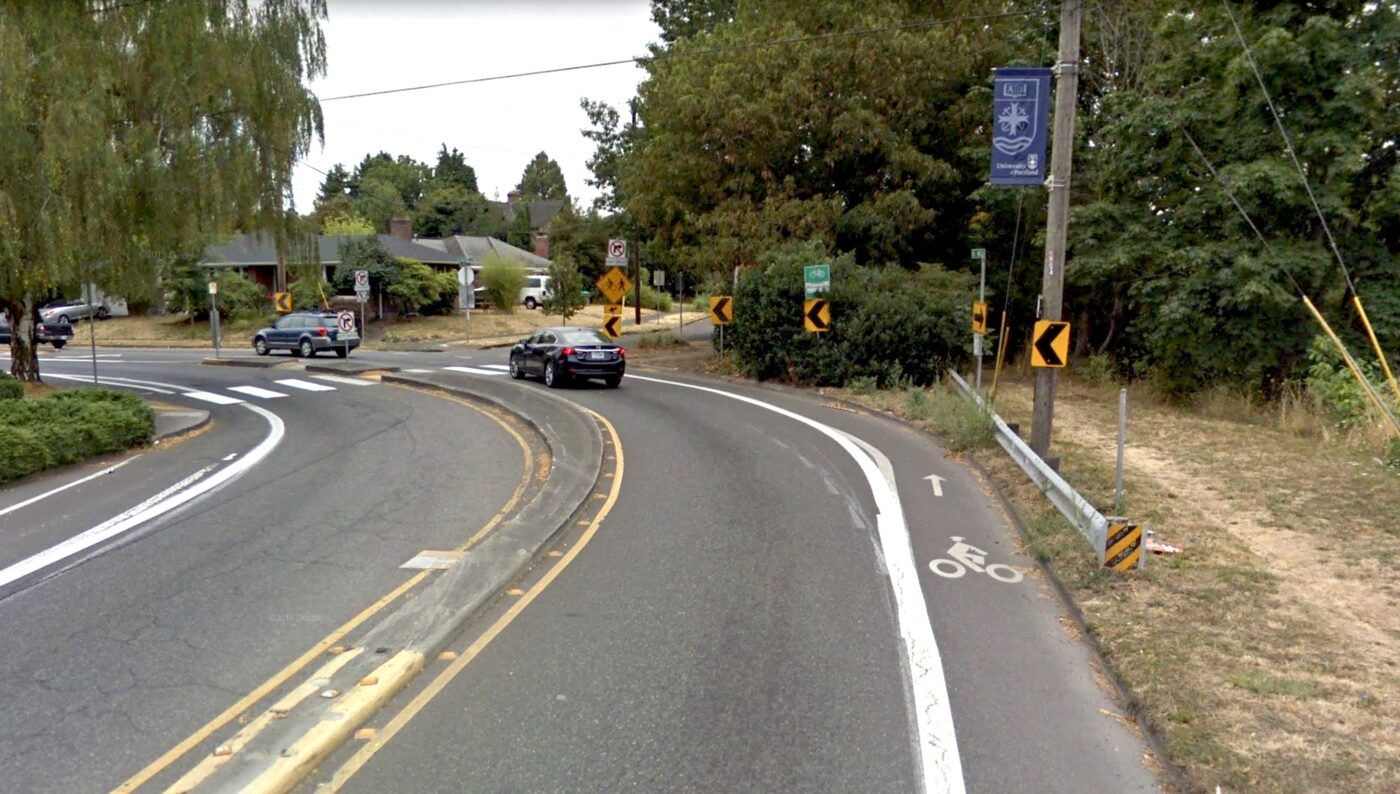
The Portland Bureau of Transportation just revealed new designs for North Willamette Boulevard that will have a huge impact on this vital north Portland cycling route. In the coming years the street will be transformed with physically protected bike lanes, floating bus islands, shorter crossing distances, safer intersections, and even a new bike path to navigate through the notorious Willamette/Rosa Parks curve.
And with the extension of the bike lane north of Alma coming as early as spring of next year, there’s a lot to be excited about.
Here’s the latest…
PBOT has reached the 30% design plans milestone for their North Willamette Boulevard Active Transportation Corridor project, a $6.1 million investment to make biking safer and easier on a three-mile segment of Willamette between North Rosa Parks Way and N Richmond Ave. The project was awarded federal funding (via Metro) to the tune of $4.45 million and is part of a host of changes PBOT wants to make to encourage more people to bike and walk in north Portland.
The 30% design milestone is where PBOT planners and traffic engineers go from conceptual plans to a clearer picture of what we can expect once the concrete is dry. This morning they revealed new design drawings for several key intersections.
One that’s particularly notable is how they plan to improve bike safety at the corner of Willamette and Rosa Parks Way (above). That corner is notoriously tight for bike riders. In 2019, activist Sam Balto garnered headlines when he laid out red cups to demonstrate how many car drivers illegally veer into the bike lane through the corner.
To remedy this problem, PBOT plans to build a paved path for southbound bike riders. The path would leave Willamette Blvd before the turn and then re-enter the street where it straightens out into the existing protected bike lane on Rosa Parks Way. Doing this will allow PBOT to remove the current bike lane striped in the southbound direction, which gives them more space to add physical protection to the northbound lanes.
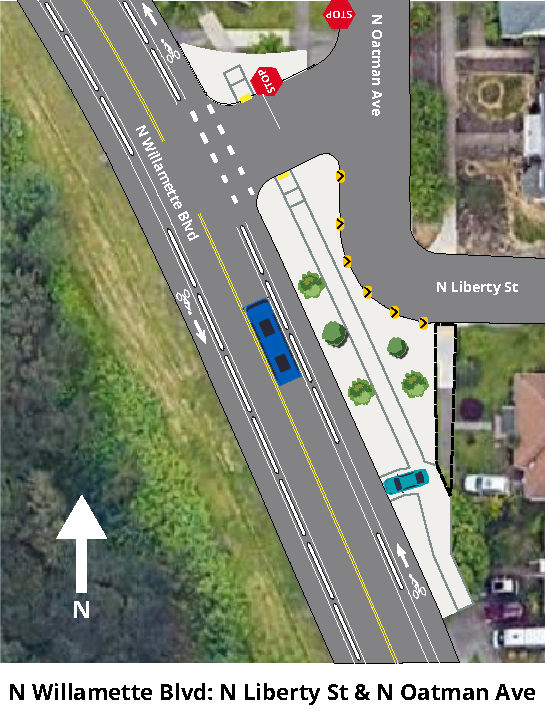
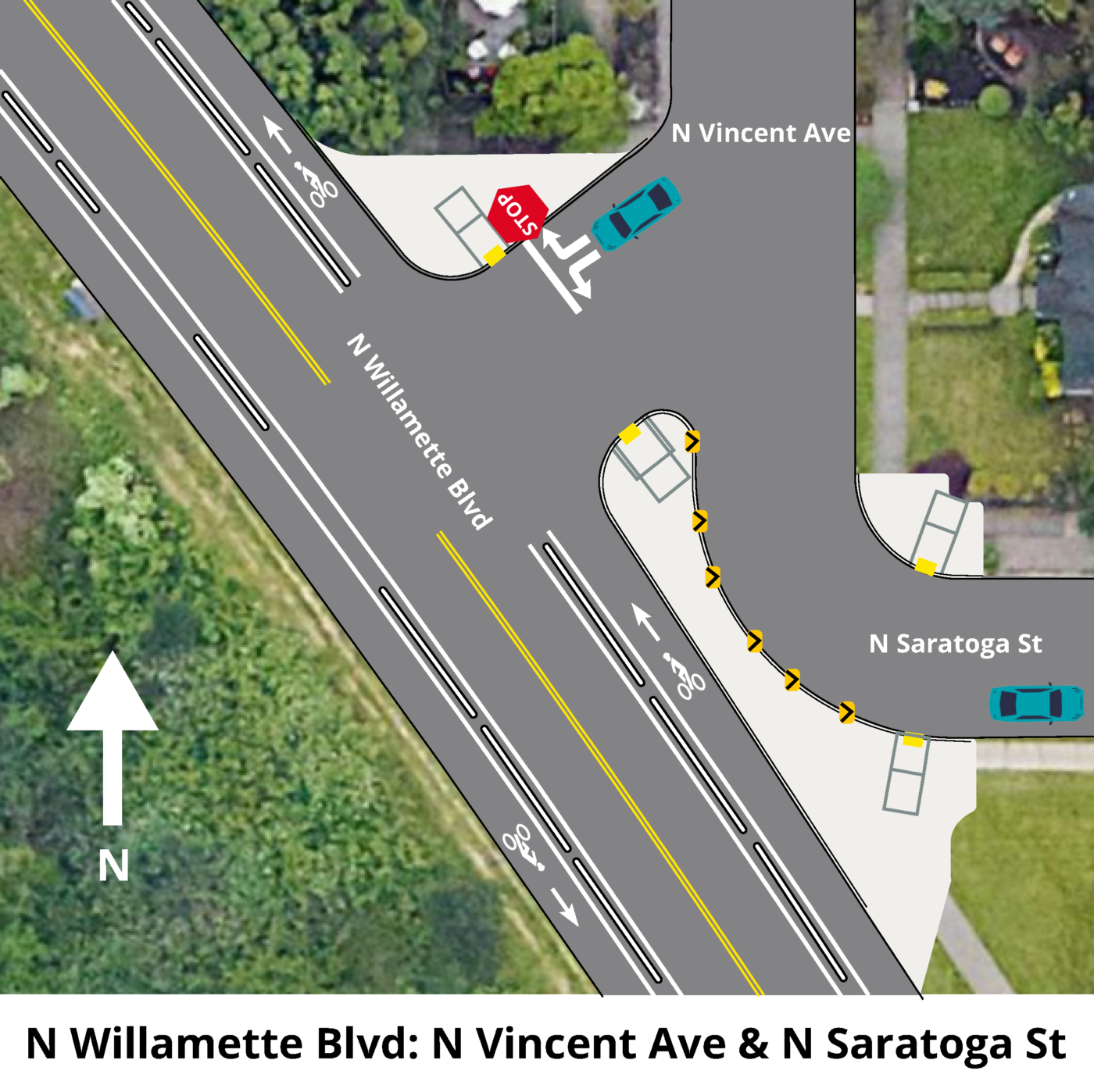
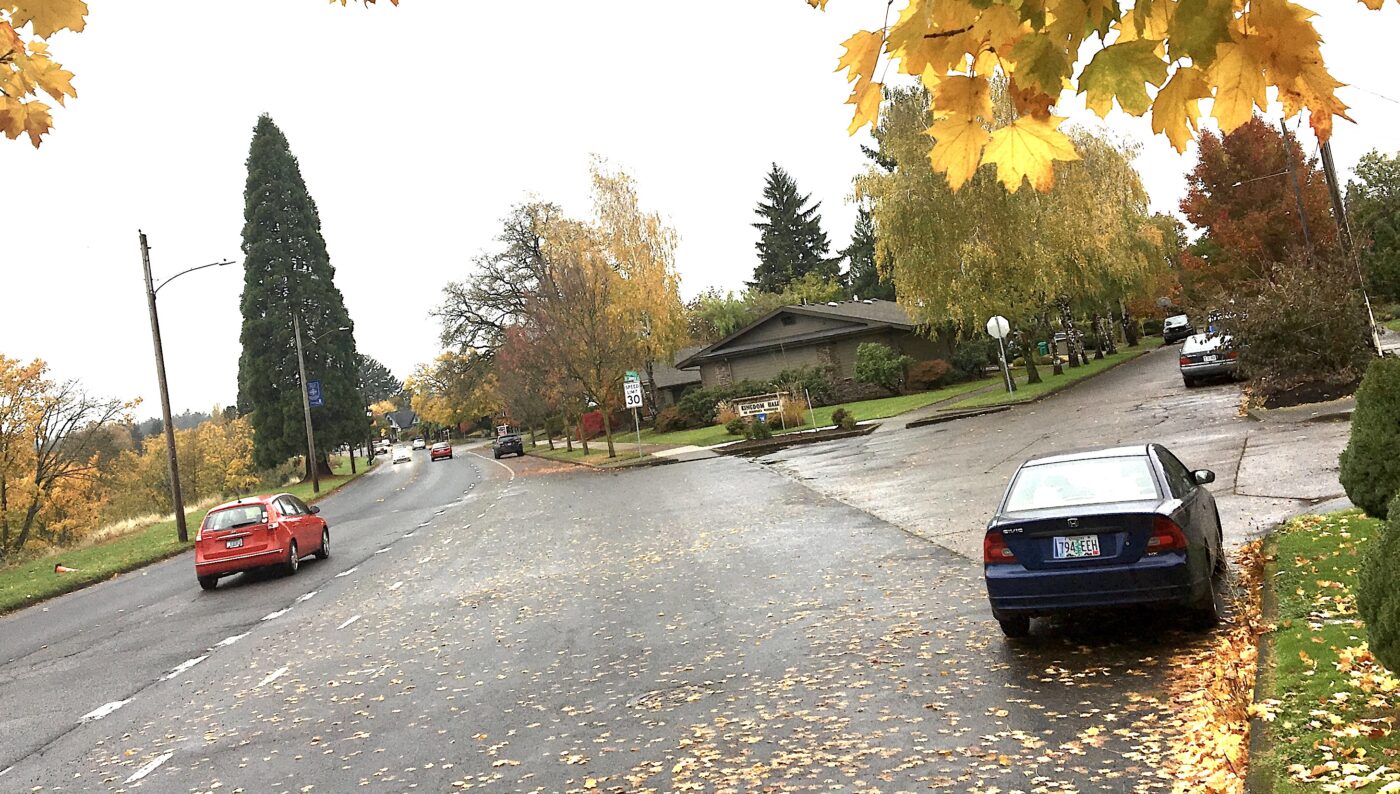
Other significant changes will happen at two intersections with Willamette just north of Rosa Parks: N Liberty/Oatman and N Saratoga/Vincent. Both intersections are currently nearly 120-feet across at their widest point. This means drivers can take corners very fast and the vast open space invites dangerous behaviors. PBOT plans to dramatically change both intersections by extending the sidewalk to create long peninsulas into the intersection. When the project is complete, the opening for drivers will be around 20 or so feet (width of two standard lanes). This will have a dramatic impact on how the street is used.
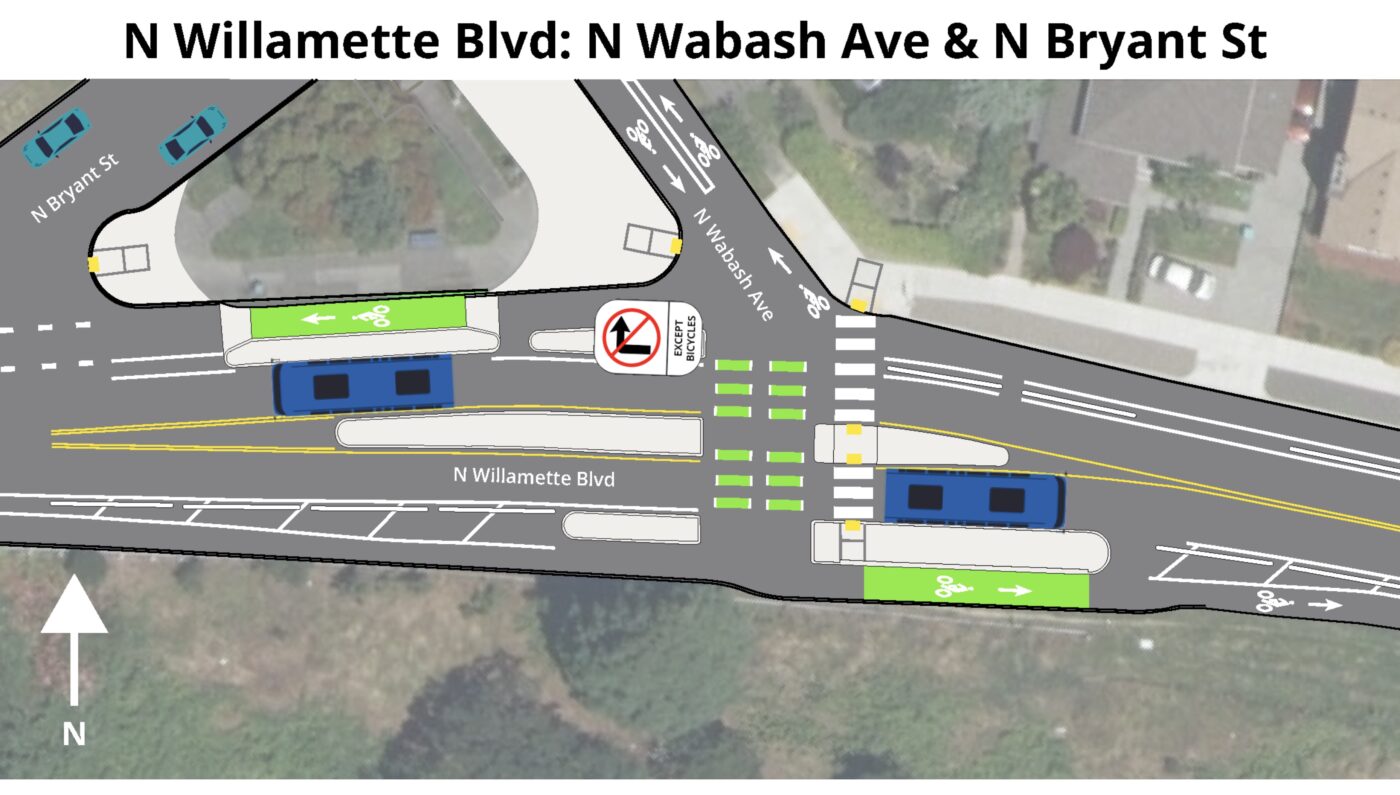
Continuing north on Willamette the new plans show the N Wabash/Bryant intersection will also get a makeover. PBOT will build floating bus stops where the bike lane goes behind the stop. This will allow TriMet drivers to stay in the lane of traffic and will speed up service. The addition of the floating medians will also further calm drivers as it will make the road space even narrower.
Another nugget revealed today is that PBOT will prohibit car use — but maintain two-way bicycle access — on the short block of Wabash between Bryant and Willamette. The plans show large curb extensions on all sides of the existing traffic island (where the bus stop is), as well as a curb extension on the northern corner of Willamette and Bryant.
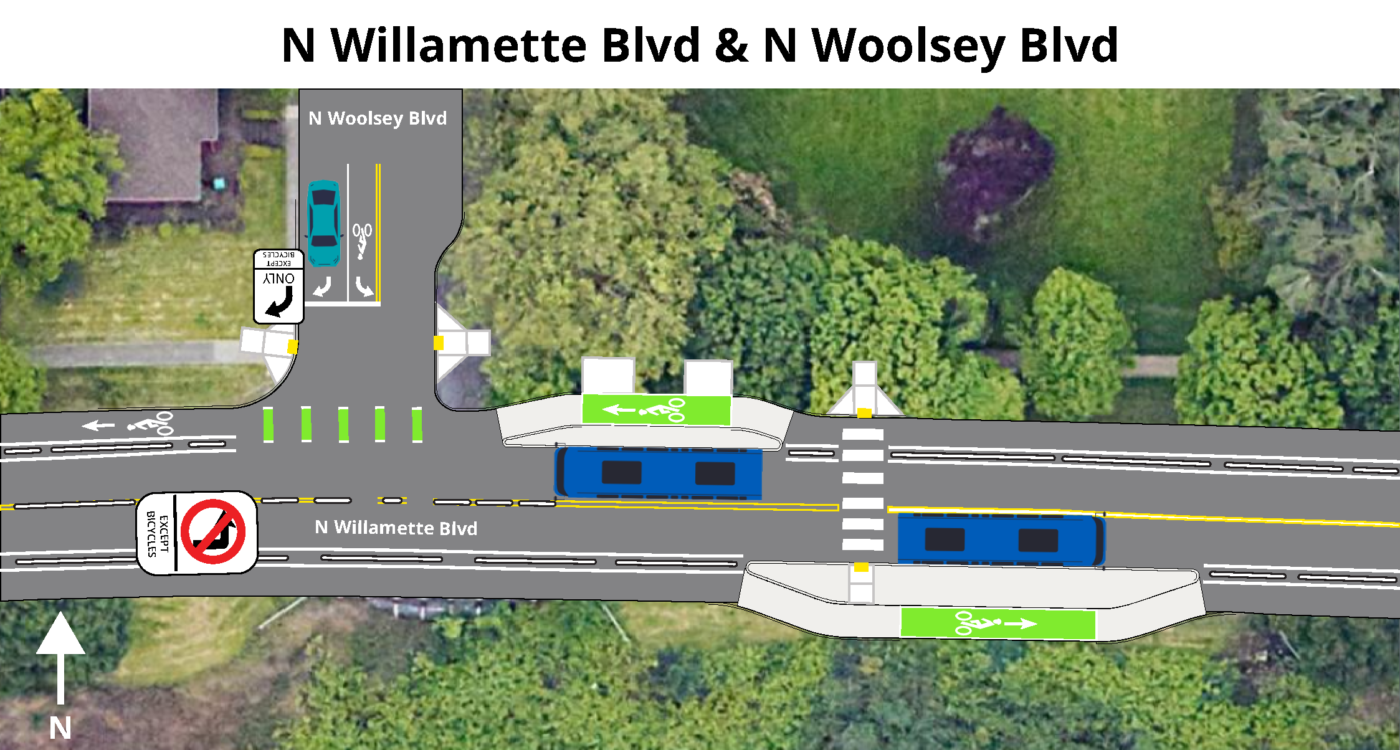
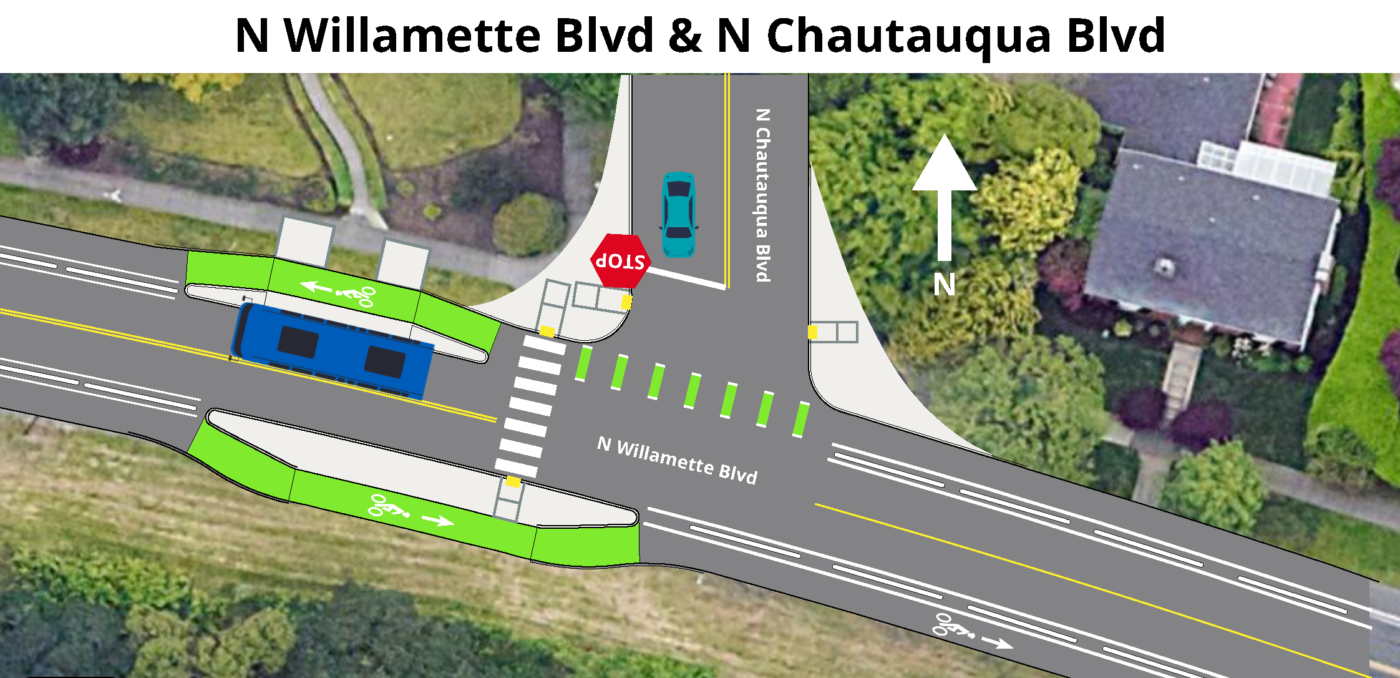
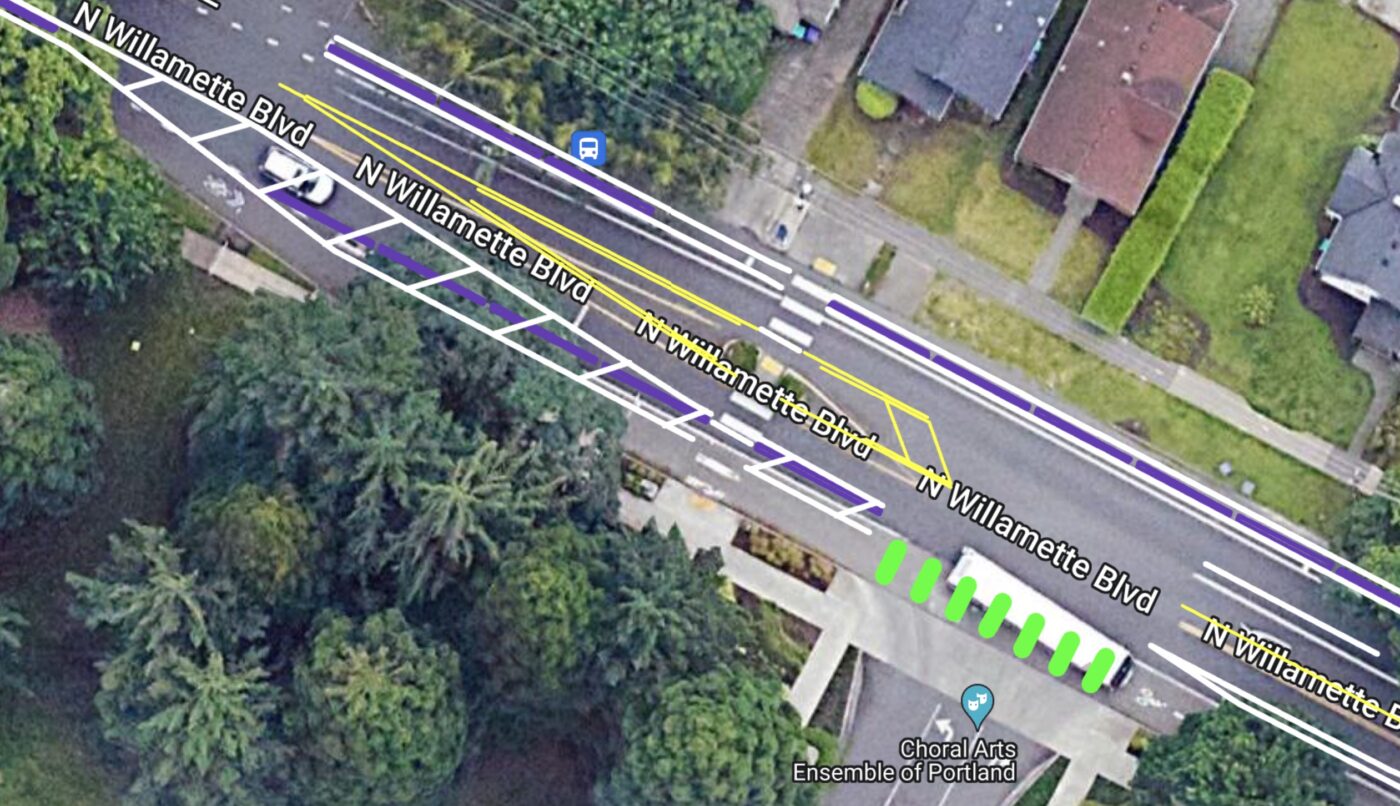
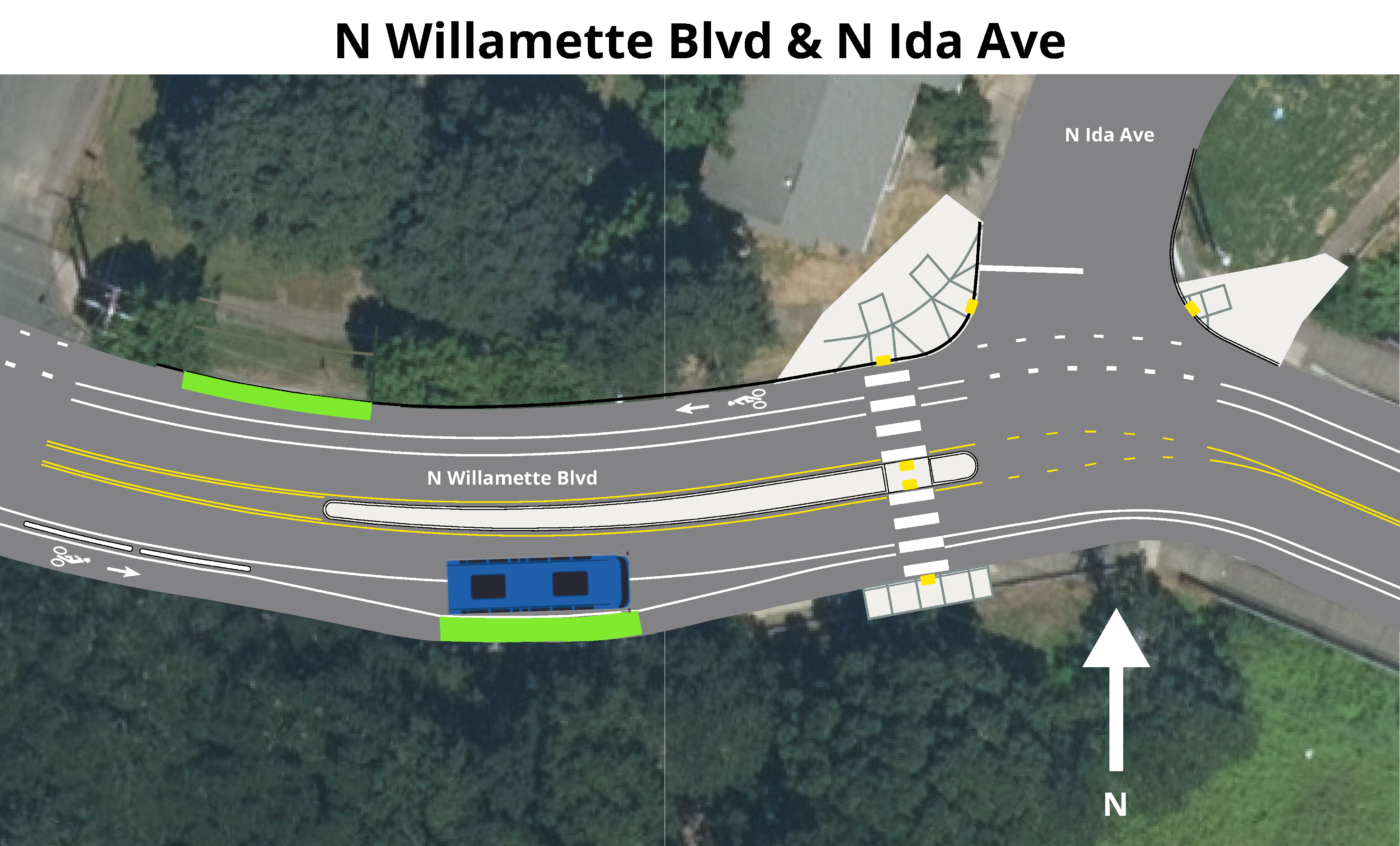
Curb extensions and floating bus islands will also be added at Willamette and Chautauqua. The intersection with Woolsey (at Columbia Park Annex) will also get floating bus stops and a new crosswalk for the stop on the south side of the street.
At the entrance to University of Portland, we’ll see a new striping pattern that will create a larger buffer between southbound bike riders.
Further north at N Ida (the railroad cut) the plans call for a center median and curb extensions to calm down the intersection and facilitate safer bus stop access.
And keep in mind that the entire three-mile corridor will have concrete curbs protecting the bike lanes. The 30% designs also show exactly where the curbs (colored purple in the plans) will go and where there will be gaps. Below is a map of the project with new plans overlayed published by PBOT this morning.
While this project won’t be complete until 2026, PBOT will get started on some of the plans before then. Next summer, a planned paving project on the 0.7-mile segment of Willamette between Portsmouth and Carey will give PBOT the opportunity to re-stripe the lanes to match what’s planned for the future project. That also means next year PBOT will remove all current on-street parking on this stretch (except for the south side of the block of N Van Houten to N Portsmouth, where the parking is inset).
Also in spring or summer 2024, PBOT will extend the existing bike lanes — which currently end right after the railroad cut at N Alma — all the way to Richmond. “This missing piece of the bike network was identified as a strong community desire during the North Portland in Motion planning process,” PBOT says. The plan is to stripe a curbside, unprotected, buffered bike lane (which also means the on-street parking will be removed) and then come back and fill that buffer with a concrete curb as part of the larger project in 2025.
PBOT plans to finish the Active Transportation Corridor project design by winter 2025 and begin construction that summer. The project is expected to last 12 months.



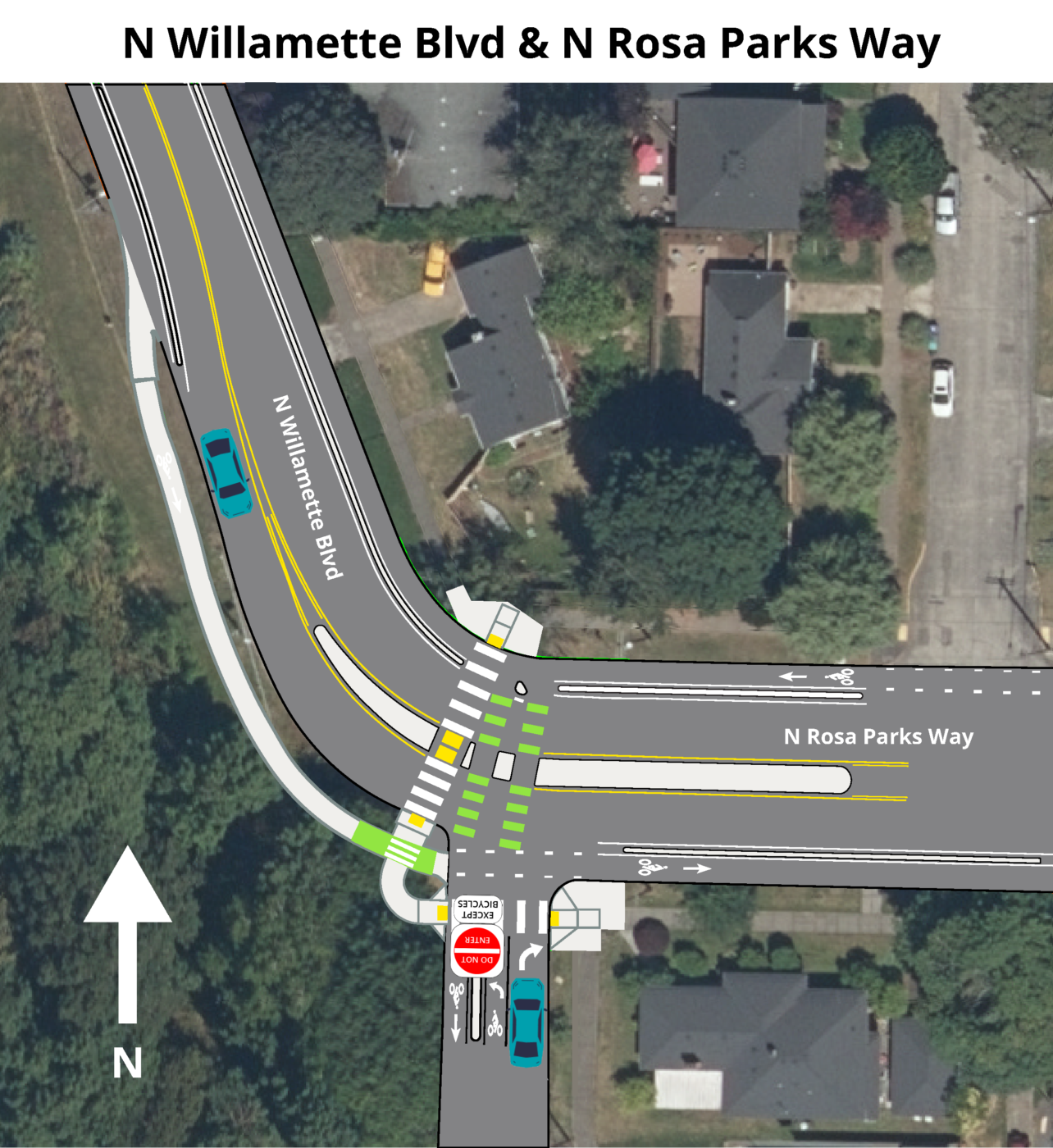
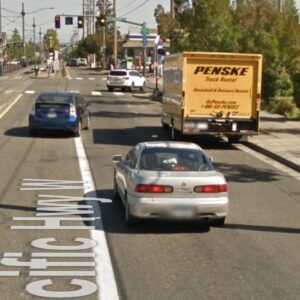
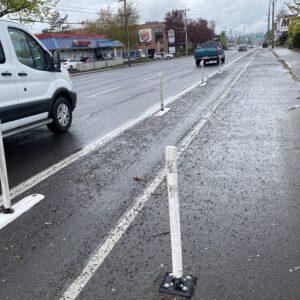

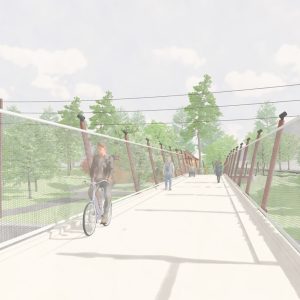
Thanks for reading.
BikePortland has served this community with independent community journalism since 2005. We rely on subscriptions from readers like you to survive. Your financial support is vital in keeping this valuable resource alive and well.
Please subscribe today to strengthen and expand our work.
Really awesome PBOT! The bus stops sort of double as protected intersections, so one potential small change would be to move the bus stop to the East side of the intersection at Chatauqua (as it would be at N Woolsey). Notice most auto turns would be 90 or more on almost all of these intersections. That slows people turning and limits the potential for right hooks. If only there were a separated path from downtown up to this to connect.
Wow, good stuff. Tucked into the end of the article is something I love to see, extending the bike lane to Richmond. That section is always so annoying, there is this huge long ride and then you abruptly have to leave the road for some bumpy zig-zagging side streets (or miss it and be thrust into a fast moving corner with car traffic). This will be a great addition. And I really like the
I’m curious about the “protected” nature of the bike lanes. It says “curbs” but I suspect they mean something similar (or the same) to what’s on Rosa Parks now. They’re slightly bumpier speed bumps. Why on earth do they have the sloped outside edge? The only function that has is to make it easier to drive over! Stop doing this PBOT! Make it a hard curb. Six or eight inches, whatever it is, sharp right angle. I want something with consequences when people negligently roll their sedans over the curbs, not just some whoopsiedoodle that would have run over a cyclist if they were there. For that matter, an actual sharp curb might give enough protection to actually redirect a car veering into the lane, whereas those rounded deals I think would let a car tire smoothly roll onto them.
I just don’t understand why they’re so afraid to do it all the way. They’re spending all this money and adding concrete, so money is not the issue. Sidewalks have sharp right angle curbs, they should do the same thing for the bicycle protection.
The sloped sides are there so your pedals don’t hit them.
Hmmm. Some of these improvements I like, some I don’t. In general, I’m in favor of the curb work and limiting car speed for getting on/off Willamette. What I don’t like is:
1. Forcing bikes to swerve around bus stops, especially if the surface is raised. This can be annoying and cumbersome if the rider is carrying cargo or traveling at higher speeds. It is unreasonable to ask bike riders to slow down when we’re unwilling to ask car drivers to do the same.
2. Forcing riders onto the sidewalk path for the left hand turn onto Rosa Parks. There should be an option for riders to take the lane here and make the left with car traffic. Bikes can take this turn faster than most cars anyway.
3. I’m not sure I like the current design for curb protection here. There are a wide range of riders on Willamette. Any option for protecting the bike lane should include enough space for passing without stressing either party. This is a 25mph speed limit street. I’d prefer to focus on controlling speed for cars, while letting faster bike riders take the lane to overtake or avoid obstacles as necessary. I’d have to see a better implementation of the protected lane before being on board with this.
Concerning point one, what is the alternative option? Other than having a sidewalk level path for the entire length of the road, I don’t see a way to avoid the up/down while having a good bus stop and a protected bike lane. And while having a sidewalk level path would be nice, it’s probably out of the budget. I don’t think it’s unreasonable for cyclists to like mildly slow down while navigating a bus stop anyways.
And for point three, physical protection is like an order of magnitude more important than ample space for faster cyclists to pass. But given that the curb probably won’t be constant, I don’t think that taking the lane will be impossible if you really do feel the need to get out and pass people.
I’m not exactly sure what an altern
blumdrew,
I agree with you that it seems reasonable to ask cyclist to route over and raise up 6″ to go around a bus stop. I hope they include adequate lighting. I recently rode form NOPO along Going-32nd-Regents-26th-Knott-28th-Ankeny in the dark. The lighitng reanged from great to dangerous for a cyclist on this route. Particulalry 26th where the street lights are spaced far apart and have been replaed with LEDs. The LEDs seem brighter and more focused than hte old lights resulting in small pools of bright light alternating with very dark patches. In those conditions, speed bumps and potholes become treacherous. Navigating the proposed bike detours will require adequate lighting, but I think the light levels are really good along Willamette.
I’m not exactly sure what an alternative is for point #1, other than keep a curbside bus stop. I’m not a particularly huge fan of the other ones I’ve seen around town (e.g. Hawthorne between Grand and 12th). Whether I’m cruising fast on a road bike, or slow on my cargo bike, they can feel somewhat uncomfortable to me. Also, on some of the busier bus stops (82nd and division) the slowdown can be much more significant. As long as there’s a good way to take the lane and go around, that’s fine with me. I just want to be able to assess the situation and make the decision I think is the best balance of safety and efficiency. By making the bike lane a “go-around” it reinforces to many drivers that bikes don’t belong on the roadway, which is wrong.
For point three, as long as the bike lane is wide enough (wider than Rosa Parks) I’d be ok with it. I’m a firm believer in creating space for all people on bikes, this includes the strong and confident types. Willamette is a very important part of many faster road rides. I don’t want slower riders to feel intimidated by faster riders passing close. On Rosa Parks I will usually find a gap in the blocks and take the lane when overtaking (even on my cargo bike). Though this is normally ok, I certainly feel safer when I can more seamlessly merge with the travel lane to overtake. Do you have data on protected vs buffered bike lanes on lower speed streets, like 25mph and under? I’d imagine the best improvement is to ensure slower vehicle speeds, but this isn’t mutually exclusive with the type of bike lane.
In general, I support protected infrastructure in many situations, but I’m unconvinced that the proposed design would improve the riding experience here. In general, I really enjoy riding on Willamette in it’s current form, save for a couple of pinch points and speeding drivers, both of which should be addressed. Either way, I’d like to see any improvements designed to maintain a nice experience for both fast and slow riders.
In general, I find the experience of a bus entering a bike lane to serve a curbside bus stop to far worse than the minor inconvenience of going up to sidewalk level for the stops shown in this design. Though the general “good-ness” of the bike lane/bus stop combo is highly variable, and I agree that the Hawthorne ones are less than ideal – though I think this is primarily an engineering problem, as the issue (for me anyways) is that the ramps are pretty sharp and the platforms feel mildly unstable at speed.
I don’t doubt this, but the current conditions on Willamette are closer to exclusive for strong and confident riders than anything else. Fixing that may involve making it less convenient for faster riding.
Slowing traffic down on Willamette would probably be effective in making it more attractive for all types of riders as well (maybe more so), but we probably have to consider what that would look like too. It’s a bus route, so a one-way filter (but two way for buses and bikes) could be a good choice. They have them at 28th and Holgate and 52nd and Division already. Evidently, PBOT is not really willing to meaningfully restrict car use on higher-order roads unless there is a clear and obvious nearby parallel route (26th for 28th, 50th for 52nd). Willamette is probably judged to be too important as a link to UP for any real changes. So what are the other options for traffic calming that don’t disrupt bus service? I’m not really sure. I guess speed bumps are an option, though I’m hesitant to support those as a bus rider.
Thanks for the pleasant exchange on this! Not sure I have the thumb strength left to keep it up the comments discussion. I’d love to continue the conversation at happy hour sometime. Look for a tiny redhead with a larger redhead. I’ll be the larger of two…
FWIW, PBOT has lowered the speed limit on Willamette from 35mph down to 25mph. Not that the drivers being asked to comply are.
Absolutely need to lower vehicle speeds here. I’d imagine speed cameras and speed displays on Willamette would be really effective.
They could improve the protection by having big gaps in it on the straight(ish) sections. I’m highly in favor of physical protection here, so I’d take improved rider comfort over the convenience of a handful of road bikes that want to pass regular people riding with their kids to school. You can deal with the minor inconvenience of giving an “on your left” and slowing down a bit. And even better if they can do some other form of protection with gaps. Really, it’s the corners that need protection the most.
I really like this solution. Call it a “strategically protected bike lane.” I’d much rather have the option to smoothly take the travel lane and go around with plenty of space so as to not impede the other riders’ experiences, while still giving plenty of protection near conflict zones. Agree that the corners could really use some protection.
Also, while I appreciate your input, I think too many people like to factionalize other bike riders. Fast riders are also normal people. I’m just as likely to be decked out in spandex as I am to be carting my kid around at 12mph. I value both experiences. We can build for both. The problem is that this sometimes takes additional space away from motor vehicles, and somehow it becomes more reasonable to ask faster riders to slow down than to ask the same of car drivers. The more bike riders of all shapes, sizes, and strengths that can have a great time, the better. Inclusivity goes in all directions.
The effort to remove legally-mandated bike lane use for cyclists might also help here. TBH we already have all the fast cyclists (that number is likely not going to be affected by infrastructure), and building protected bike lanes isn’t likely to reduce that number, however they are built.
On the other hand, without a separated network of bike lanes it’s very unlikely we are going to get the thousands of people of all ages who self-describe as “interested but concerned” to venture out on a bike.
Is “goat trail” a term for dirt paths like that? I’ve never heard it before.
Anyway improvements look good. Still kinda wish they would make the stretch along Mocks Crest a two-way cycle track and eliminate all the conflicts between Northbound riders and cars on the side streets, but whatever, I’ll defer to the experts on this.
also known as “desire lines”
“Desire path” is the term I’m familiar with. But according to Wikipedia there are quite a few synonyms:
In southwest we know them as the “sidewalk,” although I heard that an employee of Water, I think, explained to a resident that the bureau did not take “desire paths” into consideration when placing infrastructure. “But it’s our right-of-way, where we walk,” replied the agitated resident. He didn’t get anywhere.
I thought the same when they repainted the lines a few years ago. Missed opportunity. It would be a really long section of absolutely conflict-free riding, also giving cyclists on both sides the nicest view 🙂
On the other hand, the issue might be that it may be awkward to leave the bike lane to turn off of the two way cycle track. You’d want (or need) to stop in a lot of cases and that becomes inconvenient for the other riders. At least now if you need to cross, you can merge with traffic and turn against the oncoming cars which you can see while you do it.
I like the improvements, but I sure wish PBOT would address the other end of Willamette from Ida to Richmond.
Did you read the article?
Not far enough, I guess. That last paragraph is good news, indeed! None of the graphics implied changes beyond Ida and I did not read the end of the article clisely. Hence my oversight. My bad.
This is nice stuff, but I do wonder why they didn’t go for a two way path on the bluff/UP side. Feels like a good place for one
Yeah bikeway on the bluff would be sa-weet! But the price would be ridiculous given how unstable the bluff is. And in this context of the PBOT budget, it’s a nonstarter. Also, folks are mad at PBOT for even spending $6M on this project… If they even estimated the cost of an MUP on the bluff people might march downtown and throw bricks through PBOT windows!
Let’s not give anybody any ideas please
Would they really need to build out? Couldn’t they just move both bike lanes to the cliff side and move both auto lanes toward the neighorhood, all within the existing ROW?
Oh yeah they could do that. And they’ve considered it. I seem to recall they opted against it because when you have 2-ways bikes on just one side, you introduce a lot of needs for crossing to access it — and I’m sure that was a dealbreaker for them.
But there are a lot of needs for crossing under the existing proposal. Like, whatever PBOT needs to do to help southbound riders access the bluff-side lane is going to happen anyway. So why not just put the whole bikeway along the bluff side, and eliminate the need for northbound riders to cross a whole lot of streets and driveways?
The current plan doesn’t make very much sense to me.
I hear you Douglas. You should ask PBOT these questions. I’m not the engineer on the project and I’m not wedded to any option and I don’t like being put in the position of defending PBOT decisions that I had nothing to do with!
My questions really weren’t directed at you, and I’m sorry if they came across that way. They were more rhetorical than anything.
PBOT’s decision just seems weird to me. Why stripe two bike lanes when you could stripe a bikeway instead? Particularly when the bikeway could get jersey barriers down the line? (Again, not directed at you.)
Yeah, a multi-use path the whole length on the bluff side is my dream as well. We have a lot of folks running/walking on that side. I threw this basic concept image together back before PBOT had done much with their current safety measures. There are issues with this design (like how to exit onto surface streets) but I bet they could be addressed with the right project scope. I do appreciate how PBOT added width/walking lane to the bluff side at least.
That seems like the obvious choice to me. Tie it in to the Greeley bikeway, and it’s a good long middle segment of a future separated/protected bikeway from the Rose Quarter to St. Johns.
Well, with enough diverters and modal filtering, the entire street essentially becomes a bike path (with occasional car traffic). Separated bicycle infrastructure is really only needed in high-traffic areas like major commercial streets. Not saying this design necessarily reaches that level, but it’s a start.
I meant to write, “traffic calming and modal filtering”.
This is wonderful news! I just wish it wasn’t going to take so long to finish building. Summer 2027 is four years away.
I hear you Mark. But just FYI, it’s supposed to be done Summer 2026 (not 2027) and it will be great to see the outlines of the new bike lanes hitting the street this coming spring/summer.
Pretty rad stuff. My only thought would be that it doesn’t seem to do much about the danger of crossing rosa parks going north. At sunset drivers don’t see bikes crossing traffic. Maybe a flashing light?
These changes all look really good to me. I think the geometry of the bike/ped improvements at Willamette/Rosa Parks are a bit awkward. IMO, there is no need for a right turn lane here- a single lane that is right turn only for cars is simpler and better. The southbound bike lane could be wider to accommodate bikes continuing south on Willamette. The new sidewalk on the SW corner look like it speed rate for peds moving at 15 mph or greater, that could be tightened up and made more direct. Finally, it would be great to keep the option for westbound bike to use the left turn lane to access southbound Willamette- that is a regular move for me and I would miss it- I don’t like the pedestrian style crosswalk they are proposing. I get that it will work for some, but why not keep options?
I still don’t understand why the restriping from Ida to Richmond has to await except for the NIMFrontYers being upset over losing parking.
It certainly looks nice, but the protected (curbs) bike lanes on Willamette means that I’d stop riding on Willamette, just like I no longer ride on Rosa Parks.
The concrete curbs are excellent at collecting broken glass when some idiot throws his beer bottle out the window–and PBOT currently does nothing to clean up the glass.
After losing four inner tubes to the broken glass last summer (over a six-week period), I ride in other directions now.
I’m not a fan of the mini curb bike lanes either for that same reason. They collect glass, gravel, and mud. The street sweeper can’t get in there to clean it. The new lane on Division east of 205 is like this… filthy bike lane, clean car lanes.
To be fair, filthy bike lane, clean car lanes is basically the norm with or without concrete. But I prefer the concrete.
Tubeless
I’m biased because this is my ebike route to work and these look like speed reductions to me, lol.
Also willamette is clearly a pet street, it’s already extremely nice. I’d want the money to be spent elsewhere but obviously the financial terrain is still “use it or lose it”
PBOT thinking: Hmmmmm….cute little easily-mountable curbs or speed cameras that reduce the epidemic of death on high-crash corridors?
.
PBOT deciding: Cute little mountable curbs!!!1!!!
Hopefully the new concrete splitter island between the bike lanes on Willamette will reduce the (illegal) southbound cut-through traffic here, where drivers end up going the wrong way around the diverter at Willamette & Villard, which I have seen many times.
This looks great, I’m generally supportive of more intentional infrastructure. But my first thought about the diagram for proposed improvements at N Willamette and Rosa Parks Way is that this is where I rode full speed over the existing median, because of the odd angles of the bike cuts that force you to cross at a right angle to traffic. If I’m making a left onto N Willamette, I’m looking for traffic from the left, and looking for traffic from the right. I can’t do that AND dodge a maze of angled median cuts. Cut the medians along the line of travel for bikes please! I know PBOT thinks they are doing it right, parading us across the street like a carnival shooting gallery. I know motorists are out of control so we have to have concrete in the middle of the street. But at least let us ride in a straight line toward the bike lane. Riding your bike unexpectedly over a median at full speed will inspire you to make comments about engineering diagrams.
Over-engineered bull$hit!
Instead of Rah-rahing these cosmetic changes, why don’t you push PBOT to do more where collisions actually occur?
Vision Zero is a perfect name because the biking community holds the city to zero accountability about the real hazard areas, and instead ohhs and ahhs over all of this portfolio-building tripe.
Cyclists? How many of you traveling east on Willamette Blvd don’t continue along that route at Rosa Parks (should be Margaret Carter) Way and turn to see the dramatic (and unnecessary) bike lights at Greeley?
That light, incidentally, causes more near misses (auto vs auto) through driver confusion than more intuitive intersections.
And remember, idling wastes more energy and causes more exhaust than auto traffic flowing smoothly. Even in an EV.
It’s time to give your heads a collective shake. Oh, and shouldn’t the 25mph speed limit pertain to e-bikes in the bike lane?
At N Liberty/Oatman and N Saratoga/Vincent, doesn’t it seem like moving the stop signs closer to the corners, and maybe adding a few planters or barrels would be great meaasure that PBOT ccould take now? IIt would daylight the intersection, and act as traffic calming. Fix all the roads that are in disrepair with the rest. Until more funding becomes available.